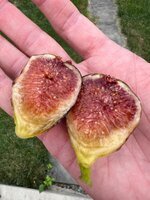Lots of interesting and contradictory (to my knowledge) info in this thread. For the sake of fullness of information, here is what Harvey, whom I respect immensely as an expert fig grower and just a humble and very honest person:
"
To the best of my knowledge, all of the Black Madeira trees originated from the same source and are genetically identical.
Slow growth is common for many Black Madeira trees, but not all. KK has a very detailed fertilizer program and gets great growth on all of his trees.
I often graft some Black Madeira scions to improve growth but also root some. If I root one tray of 12 cuttings I will see often seen significantly different rates of growth between the trees with some trees in 3 months being 24 inches tall and others only 10 or 12 inches. Over time, the slower trees usually improve and do better when moved into a larger pot. I have a hypothesis that some of the trees that have smaller/finer hair-like roots do better if given more room for their roots to expand.
The grafted Black Madeira tree I have in my orchard is pruned heavily for cuttings each winter and re-grows about 7' each year. It seems that these cuttings have lots of stored energy in them and grow quite well.
Please do not write me about Black Madeira KK, Black Madeira UCD, or Black Madeira Figaholics LOL. I sell Black Madeira. People have seemed to be quite happy with the quality of cuttings I have provided".
Here is what Harvey says about Preto on his cuttings page:
"We have two trees of this variety and had three Black Madeira and see no difference between them on our farm. Some hobbyists report that Figo Preto is earlier than Black Madeira but I believe that this is very likely just because of individual tree characteristics. On the island of Madeira there is no fig called Black Madeira and a friend of ours from Madeira and from mainland Portugal are certain that Figo Preto and Black Madeira are the same. In addition, our friend from mainland Portugal is sure that both are the same fig as a fig also known in Portugal as Violeta".
Same about Craven's Craving:
"Craven's Craving is a fig discovered in the Point Loma area of San Diego. Our video is a bit dated and our tree has grown well since the recording of the 2020 video. We continue to believe that this fig is likely the same as Black Madeira, Figo Preto, etc. with fruits of medium size, nice berry flavor, and good level of sweetness".
I don't have as much experience growing figs as Harvey, but I also noticed and strongly believe in this statement that Harvey made:
"If I root one tray of 12 cuttings I will see often seen significantly different rates of growth between the trees with some trees in 3 months being 24 inches tall and others only 10 or 12 inches. Over time, the slower trees usually improve and do better when moved into a larger pot. I have a hypothesis that some of the trees that have smaller/finer hair-like roots do better if given more room for their roots to expand."
From my own experience, I've seen good quality cuttings from a really vigorous, productive tree turn into equally excellent trees and sometimes they would grow into stragglers, all being treated equally. I've also seen quality cuttings from the same excellent mother tree grow into champions and sore losers depending on how you treat them - early up-potting, lots soil to grow roots, warm ambient temps, plenty of light, vs. keeping them in small pots for too long, inadequate lighting, etc. What's more interesting, and that contradicts what Harvey says above, is I've noticed that trees that were abused initially struggle later as well, even if you start pampering them. Not all the time, but often enough to be significant.
Which leads me to a strong belief that it's not what you grow, it's how you grow it.



